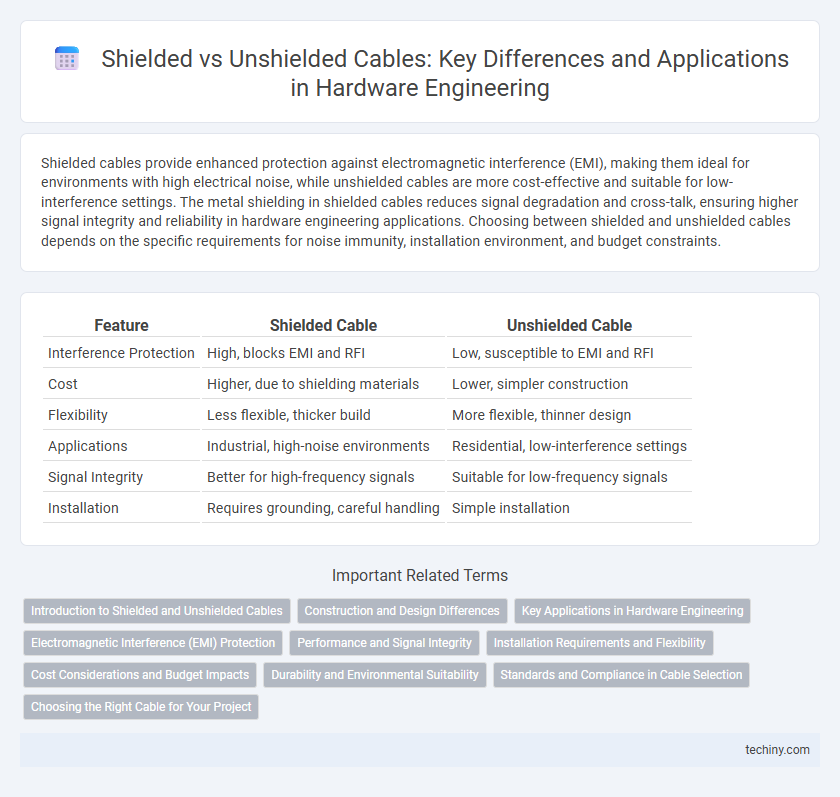Shielded cables provide enhanced protection against electromagnetic interference (EMI), making them ideal for environments with high electrical noise, while unshielded cables are more cost-effective and suitable for low-interference settings. The metal shielding in shielded cables reduces signal degradation and cross-talk, ensuring higher signal integrity and reliability in hardware engineering applications. Choosing between shielded and unshielded cables depends on the specific requirements for noise immunity, installation environment, and budget constraints.
Table of Comparison
| Feature | Shielded Cable | Unshielded Cable |
|---|---|---|
| Interference Protection | High, blocks EMI and RFI | Low, susceptible to EMI and RFI |
| Cost | Higher, due to shielding materials | Lower, simpler construction |
| Flexibility | Less flexible, thicker build | More flexible, thinner design |
| Applications | Industrial, high-noise environments | Residential, low-interference settings |
| Signal Integrity | Better for high-frequency signals | Suitable for low-frequency signals |
| Installation | Requires grounding, careful handling | Simple installation |
Introduction to Shielded and Unshielded Cables
Shielded cables feature a conductive layer surrounding the internal wires, designed to protect against electromagnetic interference (EMI) and crosstalk, making them ideal for high-frequency signals and noisy environments. Unshielded cables lack this protective layer, offering greater flexibility, lower cost, and suitability for less interference-prone applications such as standard office networking. Understanding the differences in construction, interference protection, and application environments is crucial for hardware engineers when selecting cables for signal integrity and system performance.
Construction and Design Differences
Shielded cables incorporate a conductive layer, typically made of braided copper or aluminum foil, surrounding the inner conductors to protect against electromagnetic interference (EMI) and crosstalk, enhancing signal integrity. Unshielded cables lack this protective layer, relying solely on the twisted pair design or cable geometry to reduce interference, making them lighter and more flexible but more susceptible to noise. The construction of shielded cables often includes an additional insulation layer and grounding path, increasing durability and complex installation compared to the simpler design of unshielded cables.
Key Applications in Hardware Engineering
Shielded cables are essential in hardware engineering environments with high electromagnetic interference (EMI), such as data centers and industrial automation systems, ensuring signal integrity and reducing noise. Unshielded cables are suited for low-interference settings like office networking and home computing, offering cost-effective and flexible connectivity. Choosing between shielded and unshielded cables depends on specific application requirements for signal quality, environmental conditions, and electromagnetic exposure.
Electromagnetic Interference (EMI) Protection
Shielded cables provide superior protection against electromagnetic interference (EMI) by incorporating a conductive layer that blocks external electromagnetic signals, ensuring signal integrity in hardware engineering applications. Unshielded cables lack this protective layer, making them more susceptible to EMI, which can lead to data corruption and signal degradation. In environments with high EMI levels, shielded cables are essential to maintain reliable performance and prevent hardware malfunctions caused by electromagnetic noise.
Performance and Signal Integrity
Shielded cables provide superior performance and signal integrity by minimizing electromagnetic interference (EMI) and crosstalk, making them ideal for high-frequency and sensitive hardware engineering applications. Unshielded cables are more susceptible to external noise, which can degrade signal quality and reduce data transmission reliability in environments with significant electrical interference. Selecting shielded cables enhances overall hardware performance by preserving signal integrity in demanding industrial and technological settings.
Installation Requirements and Flexibility
Shielded cables require careful grounding and proper shielding installation to minimize electromagnetic interference, increasing installation complexity and time. Unshielded cables offer greater flexibility during installation due to their simpler design, requiring fewer precautions and allowing easier routing around obstacles. Choosing between shielded and unshielded cables depends on the environment's interference levels and the need for installation efficiency.
Cost Considerations and Budget Impacts
Shielded cables generally incur higher costs due to additional materials like metal braiding or foil, increasing manufacturing complexity and price per meter compared to unshielded cables. Budget impacts include potential savings on signal interference mitigation and reduced maintenance expenses in environments with high electromagnetic interference. Unshielded cables offer lower upfront costs but may lead to higher long-term expenses from signal degradation and troubleshooting in electrically noisy settings.
Durability and Environmental Suitability
Shielded cables offer superior durability and environmental protection by incorporating an additional conductive layer that guards against electromagnetic interference and physical damage, making them ideal for harsh industrial settings. Unshielded cables, while more flexible and cost-effective, are less resistant to electrical noise and physical wear, rendering them better suited for controlled indoor environments with minimal interference. Selecting the appropriate cable type depends on the specific environmental challenges and durability requirements of the hardware engineering application.
Standards and Compliance in Cable Selection
Choosing between shielded and unshielded cables depends heavily on standards such as IEEE 802.3 for Ethernet and TIA/EIA-568 for structured cabling, which define performance and electromagnetic compatibility requirements. Shielded cables comply with stringent EMC standards including FCC Part 15 and CISPR 22, effectively minimizing electromagnetic interference (EMI) in industrial or high-noise environments. Unshielded cables adhere to basic Category standards (e.g., Cat5e, Cat6) suitable for residential and office settings where EMI is minimal, ensuring cost-effective compliance without the need for additional grounding or shielding infrastructure.
Choosing the Right Cable for Your Project
Selecting the right cable for your hardware engineering project depends on electromagnetic interference (EMI) conditions and data transmission requirements. Shielded cables provide superior protection against EMI, making them ideal for high-frequency signals and environments with significant electrical noise. Unshielded cables offer cost-effective solutions for low-interference settings, prioritizing flexibility and ease of installation.
Shielded cable vs Unshielded cable Infographic

 techiny.com
techiny.com